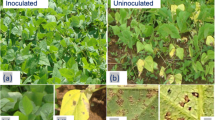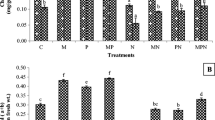Abstract
The aim of the present work was to study the effects of vesicular-arbuscular mycorrhiza (VAM) and Trichoderma virdi (T. virdi) fungi as deterrents against Rhizoctonia solani (R. solani) and Fusarium solani (F. solani) infections on the growth and quality of sugar beet. Two experiments were carried out in the greenhouse at the Agriculture Research Center, Giza, Egypt, under greenhouse conditions. The results showed that mycorrhizal and T. virdi inoculation significantly restricted the spread of both soil-borne pathogens in the host root tissues. Disease incidence of sugar beet roots was reduced to 6.2 and 5.2% for mycorrhiza with Rhizoctonia and 5 and 4.5% with Fusarium in the 1st and 2nd seasons respectively. Trichoderma with Rhizoctonia inoculation reduced disease incidence to 6.0 and 5.8% and with Fusarium to 5 and 4.3% in the 1st and 2nd seasons, respectively, compared to pathogen (Rhizoctonia and/or Fusarium) alone. In the first and second seasons, respectively, incidence of R. solani infection, in combination with mycorrhiza treatment, was reduced to 6.2 and 5.2%, and to 5 and 4.5% when amended with F. solani. Dual inoculation with mycorrhizal or T. virdi and the pathogen resulted in increasing total fresh and dry weight, nitrogen (N), phosphorus (K) and potassium (P) contents of sugar beet leaves and roots compared to pathogen-inoculated plants. Furthermore, the same treatments increased yield and quality traits of sugar beet (sucrose, total soluble solids and purity percentage). The use of this microbial model system in biological suppression of R. solani and F. solani will sustain the productivity of sugarbeet.
Similar content being viewed by others
References
Abd-Alla SN (1997). Response of Phtophthora species to vesiculararbuscular mycorrhizal fungi and fungicides. M. Sc. Thesis, Mansoura University, Egypt., pp. 152.
Abdel-Rehim MH (1984). Biological studies on Sclerotium berk. The incitant of white root rot of onion. M. Sc. Thesis, Assiut University, Egypt, 128 pp.
Abo-Ghalia Hoda H, Amany A Youssry (2000). Interaction between vesicular-arbuscular mycorrhizal Endophyta and Fusarium solani. Pepper and Eggplants. Proc. 10th Microbiol. Conf., Cairo, Egypt, 11–14 Nov., pp. 229–235.
A.O.A.C. (1990). Official methods of analysis of the Association of Official Analytical Chemists. 15th Ed. Association of Official Analytical Chemists, Washington DC, U.S.A.
Davis RM, Menge JA (1980). Influence of Glomus fasciculatus and soil phosphorus on Phytophthora root rot of Citrus. Phytopathology 70: 447–452.
Dehne HW (1982). Interaction between vesicular-arbuscular mycorrhizal fungi and plant pathogens. Phytopathology 72: 1115–1119.
El-Kazzaz MK, Hassan MA, Ghoniem KE, El-Zahaby HM (2000). Biological control of sugar beet root rot caused by certain soil borne fungi. Proc. 9th Cong. of the Egypt Phytopathol. Soci., Giza, Egypt, May 8–10, pp. 212–225. (C.F. CAB Abstracts, 2002).
Engelkes CA, Windels CE (1996). Susceptibility of sugar beet and beans to Rhizoctonia solani AG-2-2 IIIB and AG-2-2 IV. Plant Dis. 80: 1413–1417.
Gerdeman JW, Nicolson TH (1963). Spores of mycorrhizal Endogone species extracted from soil by wet sieving and decanting. Trans. Br. Mycol. Soc. 46: 235–244.
Grondona J, Pérez De, Algaba A, Monte E, García-Acha I (1992). Biological control of Cercospora disease caused by Phoma betae: greenhouse and field tests. Bulletin OILB SROP 15: 39–41.
Jackson ML (1958). Soil chemical analysis. Prentice Hall, New Delhi, India, 485 pp. 498
Jalali BL (1983). Biological suppression of root disease fungi by vesicular arbscular mycorrhizal system. Proc. 4th Intern. Cong. Plant Pathol., Melboume, Australia, Aug. 17–24, 46:183.
Kaye JW, Pfleger FL, Steward EL (1984). Interaction of Glomus fasciculatum and Pythium ultimum on greenhouse-grown poinsetta. Can. J. Bot. 62: 1575–1579.
Linderman RC (1994). Role of VAM fungi in biocontrol. In: F.L. Pfleger & R.G. Linderman (eds.), Mycorrhizae and plant health. APS Press, St.Paul, MN, USA, pp. 1–25..
Liu RJ (1995). Effect of vesicular-arbuscular mycorrhizal fungi on Verticillium wilt of cotton. Mycorrhiza 5: 293–297.
Mosse B (1973). Advances in the study of vesicular-arbuscular mycorrhiza. Annu. Rev. Phytopathol. 11: 171–196.
Phillips JM, Hayman DS (1970). Improved procedures for clearing roots and staining parasitic and vesicular-arbuscular mycorrhizal fungi for rapid assessment of infection. Trans. Br. Mycol. Soc. 55: 158–161.
Schenck JE, Kellam MK (1978). The influence of vesicular-arbuscular mycorrhiza on disease development. Florida, USA: Florida Agnc. Expt. Stn. Tech. Bull., 798: 16pp. Publisher: Gainesville, Fla.: Agricultural Experiment Stations, Institute of Food and Agricultural Sciences, University of Florida, 1969. Description: 22 p.; 23 cm. Series: Bulletin / University of Florida. Agricultural Experiment Station; no. 728
Schmitthenner AF, Hilty JW (1962). A method for studying post-emergence seedling root rot. Phytopathology 52: 177–179.
Snedecor GW, Cochran WG (1980). Statistical methods. 7th, Ed., Iowa State University Press, Ames, IA, USA, pp. 255–269.
Trouvelot A, Kough JL, Gianinazzi-Pearson V (1986). Mesure du taux de mycorhization VA d’un systeme rediculaire. Recherche de methodes d’estimation ayant une signification fonctionnlle. In: V. Gianinazzi-Pearson & S. Gianinazzi (eds.), Physiological and Genetical Aspects of Mycorrhizae. INRA, Paris, France, pp. 217–221.
Upadhyay JP, Mukhopadhyay AN (1986). Biological control of Sclerotium rolfsii by Trichoderma harzianum in sugar beet. Trop. Pest Manage. 32: 215–220.
Walker R (2001). The future of biological disease control in sugar beet. British Sugar Beet Review 69: 54–62.
Author information
Authors and Affiliations
Corresponding author
Rights and permissions
About this article
Cite this article
Aly, M.H., Manal, Y.H. Vesicular-arbuscular mycorrhiza and Trichoderma virdi as deterrents against soil-borne root rot disease of sugar beet. Sugar Tech 11, 387–391 (2009). https://doi.org/10.1007/s12355-009-0066-9
Received:
Revised:
Accepted:
Published:
Issue Date:
DOI: https://doi.org/10.1007/s12355-009-0066-9




